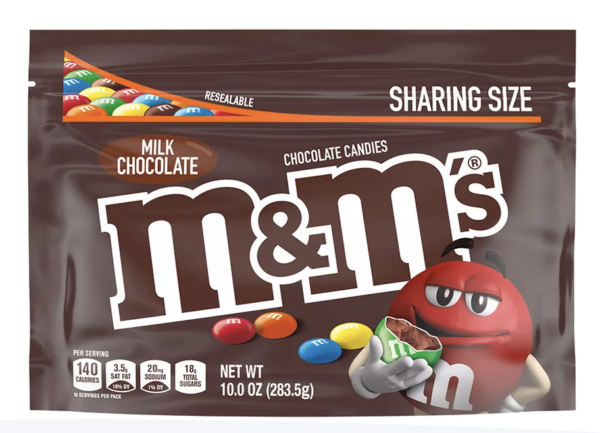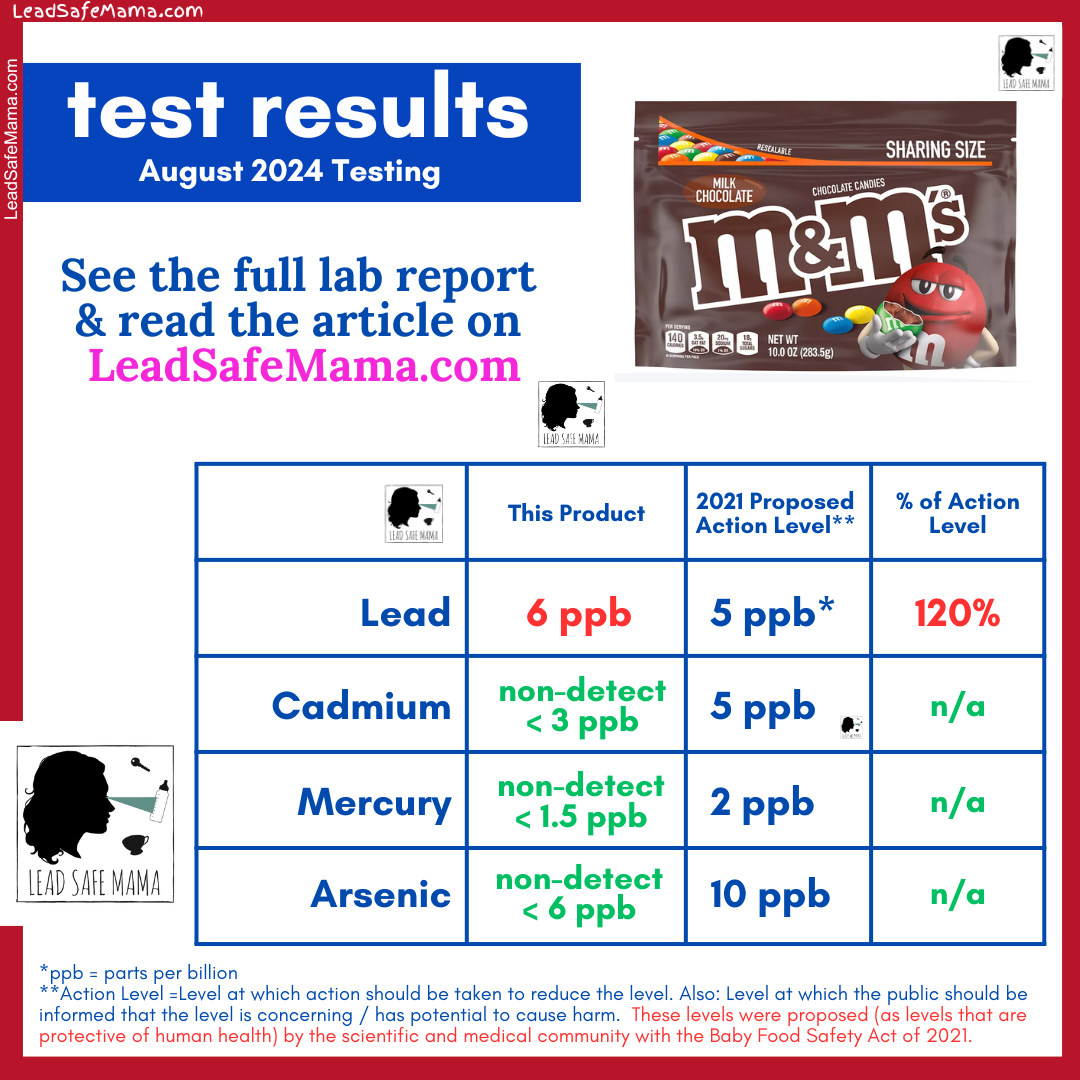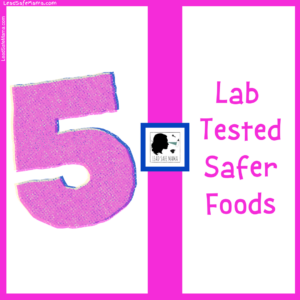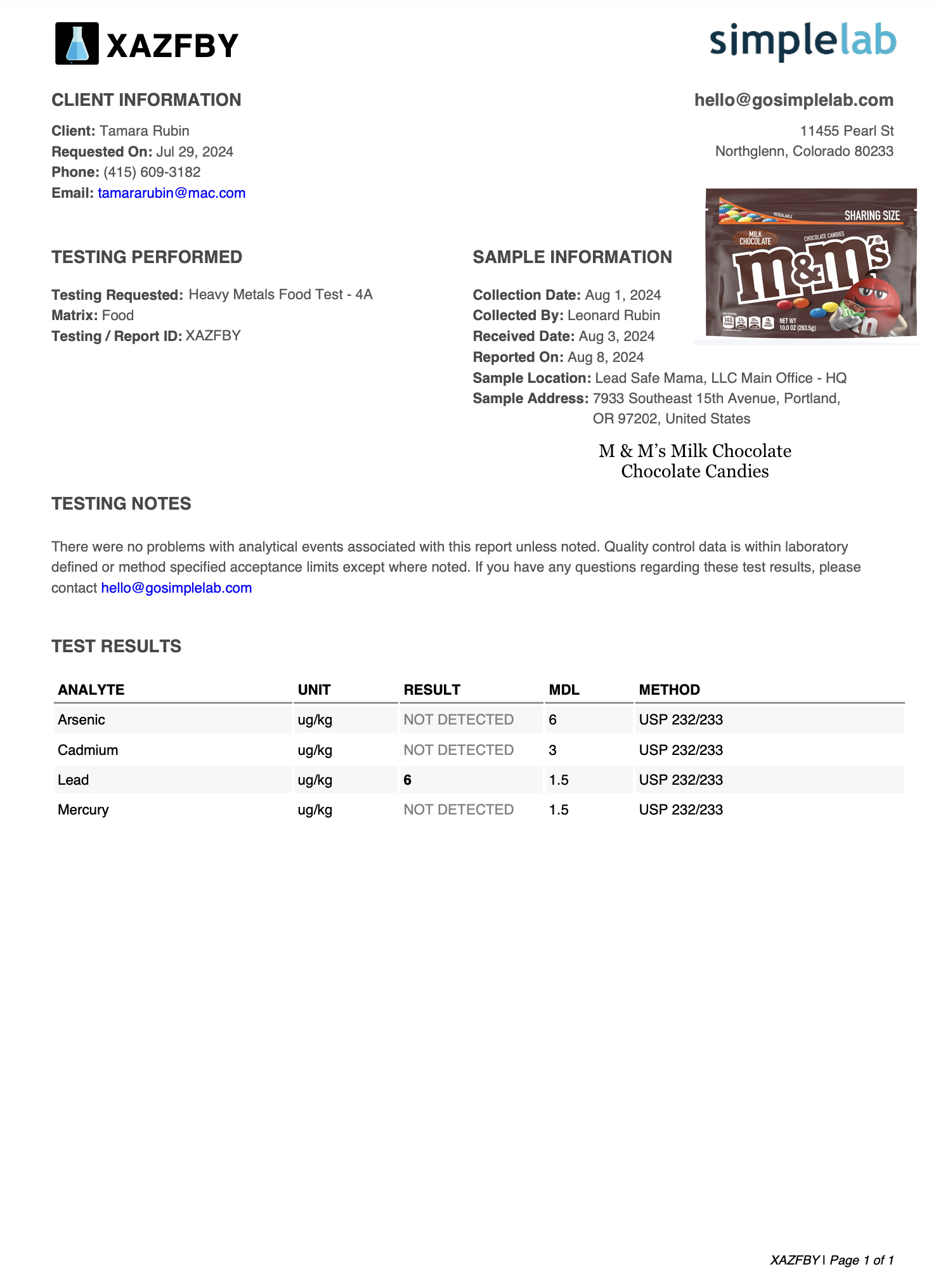M&M’s test positive for a surprisingly low level of Lead (but a level still unsafe for kids to consume)!
For those new to the Lead Safe Mama website:
Tamara Rubin is a multiple-federal-award-winning independent advocate for childhood Lead poisoning prevention and consumer goods safety, and a documentary filmmaker. She is also a mother of Lead-poisoned children (two of her four sons were acutely Lead-poisoned in 2005).
- Tamara owns and runs Lead Safe Mama, LLC — a unique community collaborative woman-owned small business for childhood Lead poisoning prevention and consumer goods safety.
- Since July of 2022, the work of Lead Safe Mama, LLC has been responsible for five product recalls (FDA and CPSC).
- All test results reported on this website are science-based, accurate, and replicable.
- Please check out our press page to see some amazing coverage of our work so far this year!
Here’s our affiliate link to the test kit Lead Safe Mama, LLC uses for the laboratory food test results we publish: https://amzn.to/3UIPcHP.
This is an ad-free article.
Advertising and affiliate income help Lead Safe Mama, LLC cover the costs of the work we do here (independent consumer goods testing and childhood Lead-poisoning prevention advocacy). We have removed ads from most of our more widely-read articles (and newly published articles, too — like this one!) to make them easier for you to read. In addition to supporting this work by starting any shopping you might be doing with a click on our affiliate links, if you would like to support the independent consumer goods testing and childhood Lead poisoning prevention advocacy work of Lead Safe Mama, LLC by making a contribution (which will also help us keep our more widely-read articles ad-free), click here. Thank you!
Important Background: What is an Action Level?
Please note the following key points:
The original lab report for this product is below (at the bottom of this page). The graphic above shows the levels of metals detected in this product (in red) along with the low threshold of detection (in green) for each metal not detected with the laboratory testing Lead Safe Mama, LLC had completed for this product. The numbers are juxtaposed (in blue) to the “Action Level” proposed by the medical and scientific community in 2021 as part of the Baby Food Safety Act.
- These levels were set as “Action Levels,” which are (in fact) protective of human health.
- An “Action Level” is NOT the same as a “Maximum Allowable Level.”
- Once something is as toxic as the “Action Level,” it is officially in the realm of heavy metal levels that can cause lasting harm to children.
- Action Levels are not related to serving size.
- Action Levels are relevant for any amount of a food product that may be consumed (any quantity of the food in question).
- PPB (parts per billion/ ppb) measurements are a percentage (albeit a very small percentage) and apply to any quantity of a food product.
- For more discussion about serving size considerations (and why relying on “serving size” to limit toxicant exposure is not a relevant metric protective of human health), read this article.
- The “Action Level” is the level at which the scientific and medical community believes the company (or government) needs to take ACTION to fix the problem (which also includes taking ACTION to inform the public that their product has an unsafe level of the metal detected at-or-above the “Action Level” — and which relevant batch numbers should be recalled/ not consumed).
- These Action Levels are not arbitrary, however they were not passed into law.
- These Action Levels reflect the current advice of the medical and scientific communities as levels both achievable and protective of infants and toddlers — regardless of the fact it is legal for food for children to test positive at these levels (given the Baby Food Safety Act of 2021 was not passed into law).
- Food industry lobbyists fought back against formalizing these proposed “Action Levels” as a government standard, alleging they were unachievable.
- The image below (with the number FIVE) links to a landing page with FIVE food products we have already tested this summer, all of which have been “non-detect” for toxicants with low thresholds of detection (for Lead, Mercury, Cadmium, and Arsenic) far below the 2021 proposed Action Levels.
- These FIVE food products (about 10% of the foods Lead Safe Mama, LLC has tested so far just since March 2024, when we started laboratory testing foods) clearly demonstrate these Action Levels to be achievable — across a range of food types (salt, flour, coffee, oatmeal, and chia seeds).
- The legitimacy of these levels as “Action Levels”/ “Levels of Concern” (even though they were not adopted as law) is further supported as the situation is similar to the legitimacy of the America Academy of Pediatrics’ level of concern for Lead in water — which is 1 ppb — even though the FDA’s official “level of concern” for Lead in water is 15 ppb (you can read more about that here).
For safer food choices, click here.
Published: August 10, 2024
A full lab report for the product pictured is below.
Please scroll down.
We sent M&M’s Milk Chocolate candies to a third-party independent laboratory for testing and found they tested positive for Lead.
While the level of Lead found in these popular “mainstream” candies is unsafe for consumption by children (per the recommended Action Levels noted above), we were frankly surprised by how low the Lead level was (compared to other chocolate-flavored food products we have tested) — and were also surprised by the fact that this product tested negative for Cadmium (unlike most of the other chocolate flavored products we have tested, which have been consistently positive for both Lead and Cadmium)!
Here are some links to lab reports for some of the other chocolate-flavored food products we have tested for comparison:
- Envirokidz Koala Crisp chocolate-flavored cereal
- Seven Sundays chocolate-flavored sunflower cereal
- Simple Mills Seed & Nut Flower Sweet Thins in mint chocolate flavor
Important Points
- In the above graphic showing the level of Lead detected in this product, we are comparing the level detected with the health-protective standards proposed by the medical and scientific community in 2021 (the “Action Levels” noted above).
- The level of Lead we found in this food product is not illegal because the presence of Lead in food intended for consumption by children is not currently officially limited or regulated by the FDA.
- In January 2023 the FDA issued a follow-up “Draft Guidance” regarding the presence of metals in foods that may be consumed by children.
- The “guidance” is primarily focused on Lead contamination of specific categories of foods children may eat.
- These “guidance” levels are also not in the form of enacted and enforceable legislation — so food manufacturers are actually not required to adhere to them.
- Here’s a link to the January 2023 Draft FDA “guidance” initiative.
“What about Prop 65 Compliance?”
The company (any company) says they are compliant with “Prop 65!”
Prop 65 considerations are not relevant (even though they are often referenced by food manufacturers attempting to justify the presence of toxicants in their food products), as Prop 65 limits are based on “serving sizes.” All federal agencies agree there is no safe level of Lead exposure. Even if there were an “acceptable” amount of a carcinogen (or neurotoxin, as it were) to have in a food intended for children’s consumption, “serving sizes” set by food manufacturers are typically unrealistically low (compared to how much of the product a child might actually eat in one sitting — or in one day) and as such are not relevant when considering actual exposure risks presented by certain foods. You can read more about that at this link.
The rise in cancer in younger people is perhaps not so surprising given the presence of Lead and Cadmium in so many popular packaged foods and snacks
Recent news coverage indicating an increase in cancers with younger generations has emphasized that our younger generations’ reliance on ultra-processed foods is likely a significant contributing factor.
Given so many processed foods also test positive for unsafe levels of two substances classified as carcinogens (Lead and Cadmium), the role of processed food in the current cancer epidemic is possibly even more significant than researchers have estimated to date. One recent study noted that “Seventy-three percent of the food on the grocery store shelves in America is ultra-processed” (read more here). What a lot of consumers do not understand is that ultra-processed foods can also include foods with an “organic” (or “natural”) label. Just because something is organic (or “all natural”) does not mean it is not ultra-processed. (See more info on that here.)
- To see a full list of all the foods we have tested and reported on (plus the related articles we have written) since we started conducting food testing for Lead, Cadmium, Arsenic, and Mercury in March 2024, click here.
- To see a full list of all the foods we have pending/ currently at the lab (and all of the items we are seeking community funding for future testing and reporting on), click here.
- For safer snack choices for your children, click here.
- For general guidelines on avoiding Lead (and other toxicants) in your diet, click here.
- For a comprehensive discussion of the concerns for Lead in baby food, click here.
- For a list of products we have tested that resulted in negatives (non-detect) for Lead, Cadmium, Mercury, and Arsenic, click here.
A few more key background points:
- Lead Safe Mama, LLC is a unique community collaborative woman-owned small business in which YOU (Our community: Readers of this website and followers of our social media channels) decide what we test and you (our community) help cover the cost of that testing.
- The testing we report on is truly independent third-party testing — community-driven and community-funded — not influenced by any agency, person, or business.
- We are sharing this scientific information (laboratory test results for food products that the Lead Safe Mama community has asked us to test, and that the Lead Safe Mama community has funded testing for) with you (Lead Safe Mama readers) to help you make informed decisions for your family.
- We are not doing this to cause panic, fear, or anxiety.
- Most other organizations and businesses completing food testing are not sharing the actual lab test results for the food products they are testing.
- We have chosen to lift the veil of mystery and share the actual lab reports so you have hard data to use as a basis for any decision-making you need to do.
- We are confident that you are smart enough to understand what the numbers mean (to take the time to learn what they mean) and use this as a basis to make informed decisions for your family.
- While none of us can change the past, we can at least hopefully take the time to learn about the toxicant profiles of the foods we feed our families and use that information to make the best choices we can moving forward.
- We’re also hoping that sharing this scientific information publicly (not behind a paywall) will raise public consciousness about this issue, perhaps enough to create a shift in consumer demand that will in turn disrupt the food industry (forcing the industry to make changes for the better).
- #KnowBetterDoBetter
The most important question to ask yourself right now…
If you had known that this product tested positive for an unsafe level of Lead, would you have chosen it for your family? For me the answer to this question is a resounding “no!”
Our recommendation is that children should not eat this product (or other products where chocolate or cocoa powder is a primary component/ more than just a flavor of the food item). We understand that others may choose to use this information to make different choices for their family based on their own standards and/or circumstances — and we think no one should be judged or criticized for making whatever choices seem right for them.
Hopefully the information we provide will help you make whatever choices you make with a foundation of knowledge and facts (rather than selecting products based on blind acceptance of the marketing hype and spin found in the greenwashed language and manufacturer’s claims).
The test results for this food product support the following considerations:
- As a society, we really need to reconsider how and what we are feeding our children.
- At minimum, as parents, we need to consider eliminating (at least significantly so) highly-processed (made by machines) snacks based from any kind of processed flour (including seed and nut flours).
- Note: In our testing to date, processed packaged food products made of flour (any type of flour) appear to be more contaminated than some other products — likely both as a result of contamination introduced by the mechanized grinding and processing of the ingredients used to make the flours in addition to contamination likely introduced during the machining process required to make the final shaped/ formed product (cereal O’s, puffs, or cookies, etc).
- We also need to consider limiting/ eliminating ANY TYPE of store-bought processed, packaged snacks from our children’s diets whenever possible (not just the flour-based products).
- Given the current state of chocolate contamination across the board, we recommend significantly limiting consumption of any products that are made primarily of chocolate/ cocoa powder, etc. as well.
- Societally, we need to more closely examine how our culture of eating processed, packaged food (which frequently tests positive for high levels of known carcinogens, like Lead and Cadmium) is impacting cancer rates, types, and what we can do in response to these findings.
- The epidemic of cancer in the United States is not generated by some mysterious source — we are accumulating ample evidence that it is clearly rooted in widespread contamination of our food supply (contamination primarily found in processed, packaged foods).
- We need to demand more from our food supply chain (every step of the way: Not just the process of growing food ingredients, but the entire system, including harvesting, processing, packaging, and distribution).
- We need to demand that profit-driven corporate interests (no matter how large or small the corporation) stop manufacturing and selling contaminated products — especially food products with contaminants like Lead and Cadmium, two toxicants that are well-established as causally linked to countless life-long health impairments (and are also toxicants that accumulate in the body over a lifetime).
- As consumers, we need to demand (and advocate for) effective regulatory oversight of the food industry.
- Finally, we need to demand greater accountability and higher standards related to the language used for marketing and selling products — especially products ostensibly being sold as “healthier” and/or “more natural” choices for children.
I have been feeding this product to my kids — what should we do now!?
If you have been feeding M&M’s to your young children (or consuming them yourself) on a regular basis — and if you or your child has not had a heavy metals panel completed recently — out of an abundance of caution we recommend you stop eating this product immediately and consider getting a full heavy metals panel, including testing for Lead, Arsenic, and Cadmium (to help determine if they or you have had any exposure of concern from eating this and other similar products).
We always encourage you to rely on science to help you make informed decisions for your family.
- Ask your doctor about getting tested.
- Having baseline heavy metals testing performed for everyone in your family is a good place to start.
- Heavy metals panels can be done with a urine, blood, or hair testing.
- We discuss considerations related to heavy metal panels done with urine testing and hair testing at this link.
Hopefully you and your children will all test negative for Lead, Cadmium, and Arsenic after regularly consuming a product like this, but it is better to get a test and know the answer (to have a baseline for future comparative testing) than to not test at all.
Some additional reading & links that may be of interest:
- This is the Lead Safe Mama affiliate link to purchase the test kits we used for this testing.
- This page has a full spreadsheet listing of all the food testing we have completed and that we have in-progress.
- Here’s our landing page with links to all the results for food products we have tested.
- Here’s how to send your own food samples into a lab for testing (the cost is $195 per single food sample tested for Lead, Cadmium, Mercury, and Arsenic) or how to collaborate with Lead Safe Mama, LLC on the food testing we’re hosting.
- Check out the Food category of articles here on Lead Safe Mama dot com.
Amazon links are affiliate links. If you purchase something after clicking a Lead Safe Mama, LLC Amazon affiliate link, we may receive a percentage of what you spend at no extra cost to you.
Never Miss an Important Article Again!
Join our Email List










Thank you for your courageous, invaluable work. I’ve sent you a message today on Facebook asking if I could pay you to look at photos of some of my vintage china (mostly dinner plates), including the name of the brand and manufacturer on the back.
I hope to hear from you soon and thanks again.